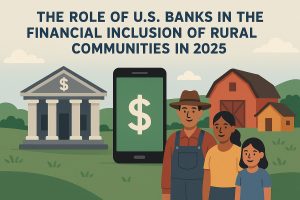Interest rates are a cornerstone of modern financial systems, shaping the economic landscape in profound ways. In the United States and Canada, changes in interest rates not only affect the daily lives of consumers but also influence the strategies and decisions of investors.
Understanding these impacts requires a deep dive into how interest rates function and their ripple effects across economies.
The role of interest rates in the economy

Interest rates serve as the cost of borrowing money or the return on savings. Set by central banks such as the Federal Reserve in the U.S. and the Bank of Canada, interest rates are a primary tool for regulating economic growth. When rates are low, borrowing becomes cheaper, encouraging spending and investment. Conversely, higher rates discourage excessive borrowing and curb inflation by reducing spending.
For consumers, interest rates influence the affordability of loans for major purchases, such as homes and vehicles. A lower interest rate environment can make mortgages and car loans more accessible, while higher rates may push these aspirations out of reach for some households. This dynamic underscores the critical role interest rates play in shaping financial stability and access to credit.
For businesses, the cost of borrowing affects their ability to finance expansion, invest in new projects, or even maintain operations during challenging economic times. Investors, in turn, respond to these business trends, as they seek opportunities for returns that align with the prevailing interest rate environment. These interconnections highlight the systemic importance of interest rates in both consumer and investor behavior.
Impact on consumer borrowing and spending
One of the most visible effects of interest rate changes is their impact on consumer borrowing. When central banks lower rates, borrowing becomes more attractive. Credit card interest rates, personal loans, and mortgages typically decrease, incentivizing consumers to take on debt for purchases or investments. This increased borrowing can boost economic activity, as more money flows into the market.
However, the reverse is also true. When interest rates rise, borrowing costs climb, leading to reduced consumer spending. Higher mortgage rates, for example, can make homeownership unaffordable for many, slowing down the housing market. Similarly, increased interest on credit card balances and personal loans may cause consumers to tighten their budgets, limiting discretionary spending.
The effects of interest rates extend beyond borrowing. Savings rates, which tend to rise alongside interest rates, can encourage consumers to save rather than spend. While this might seem like a prudent financial decision, reduced consumer spending can dampen economic growth, highlighting the delicate balance policymakers must maintain when adjusting interest rates.
Influence on investment decisions
For investors, interest rates are a key factor in determining the attractiveness of various asset classes. When rates are low, fixed-income investments like bonds typically offer lower yields, prompting investors to seek higher returns in equities or real estate. This shift can lead to increased stock market activity and rising property values, as demand in these sectors grows.
Conversely, rising interest rates often make bonds and other fixed-income securities more appealing, as they offer better returns with relatively lower risk. This dynamic can lead to a reallocation of investment portfolios, with investors moving away from equities and real estate in favor of bonds. The resulting shifts in capital flows can significantly impact market performance and asset valuations.
Moreover, interest rate changes influence corporate behavior, which in turn affects investors. Higher borrowing costs can limit a company’s ability to invest in growth initiatives, potentially reducing future earnings and stock performance. On the other hand, low rates can fuel corporate expansion, creating opportunities for higher returns in equity markets. These complexities underscore the interconnectedness of interest rates, corporate strategy, and investment outcomes.
Regional similarities and differences
While the United States and Canada share many economic similarities, their responses to interest rate changes often differ due to variations in market structure and consumer behavior. In the U.S., the economy’s size and diversity mean that interest rate adjustments can have a wide-ranging impact. From Wall Street to Main Street, changes in rates affect everything from federal borrowing costs to the price of everyday goods and services.
In Canada, the smaller and more resource-dependent economy creates unique challenges and opportunities. For instance, higher interest rates can disproportionately impact industries like energy and mining, which are vital to the Canadian economy. Additionally, the Canadian housing market, characterized by higher household debt levels, is particularly sensitive to interest rate changes.
Despite these differences, both nations experience the global repercussions of interest rate shifts, particularly as financial markets become increasingly interconnected. Investors in both countries must consider not only domestic policy decisions but also international trends, such as those set by the European Central Bank or the Bank of Japan. This global perspective is crucial for navigating the complexities of modern financial systems.
Long-term implications for economic growth
Over the long term, interest rate trends can shape the trajectory of economic growth in profound ways. Sustained low interest rates may encourage over-leveraging, as consumers and businesses take on excessive debt. While this can drive short-term economic gains, it may also lead to asset bubbles and increased vulnerability during economic downturns.
On the other hand, prolonged periods of high interest rates can stifle innovation and growth by making borrowing prohibitively expensive. Small businesses, which often rely on loans to fund their operations, may find it challenging to compete in such environments. Additionally, consumers facing higher borrowing costs may delay major purchases, further slowing economic activity.
Central banks in the U.S. and Canada face the ongoing challenge of balancing these outcomes. Their decisions must consider not only current economic conditions but also the potential long-term effects on financial stability, employment, and inflation. For consumers and investors alike, understanding these dynamics is essential for making informed decisions in an ever-evolving economic landscape.
In conclusion, interest rates are a powerful economic lever with far-reaching effects on consumers and investors in both the United States and Canada. From influencing borrowing and spending habits to shaping investment strategies and economic growth, the role of interest rates cannot be overstated. By staying attuned to these shifts and their implications, individuals and businesses can navigate the complexities of modern financial systems with greater confidence.






